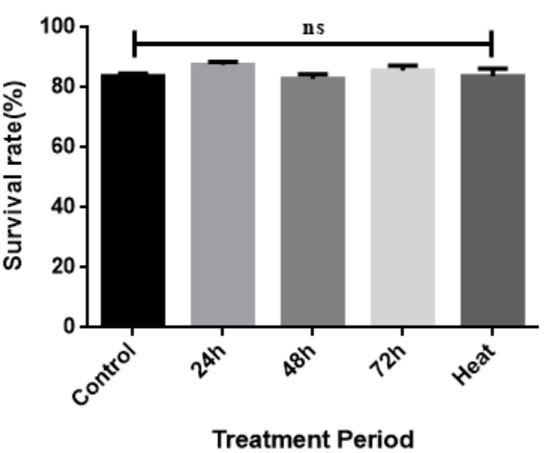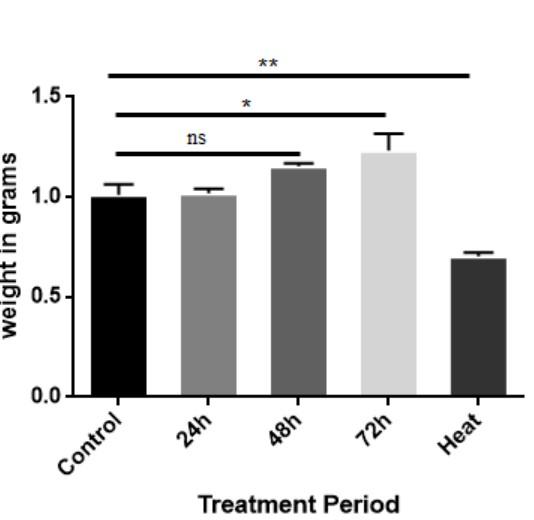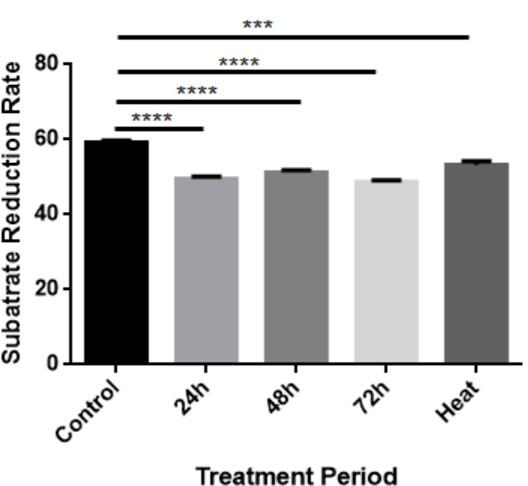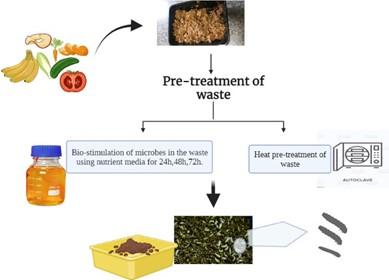Influence of fruits and vegetables waste pre-treatment on black soldier fly larval growth
Abstract
Hermetia illuciens, commonly known as black soldier fly (BSF) can convert organic biomass into manure and insect biomass into protein and fat. Currently, in the waste management industry, BSF larvae are predominantly used to convert valorized organic substrates into fertilizer and to produce biogas. They are also alternatively used as viable protein substitutes for animal feed as well as human consumer products. The treatment of organic wastes before BSFL consumption indicated a positive stimulation in the biomass conversion rate, larval growth rate and overall larval performance parameters. The current study was designed to analyze the effect of the bio-stimulation-based pre-treatment strategy of the feed on performance parameters, such as larval weight, larval survival rate, substrate reduction by pre-treatment of biowaste for better growth, efficient performance, and good biomass composition in BSFL. In our study, we noticed significant up- and downregulation of several larval parameters by assessing substrate composition, larval growth parameters and substrate reduction rate. The bio-stimulated waste showed larval weight gain when compared to larvae grown in control feed. The heat pretreated waste was not suitable for larval growth as the parameters assessed were observed to be declined. Further investigations are needed to comprehend how BSFL reared on pretreated substrates enhances the nutritional composition of larvae.
INTRODUCTION
Owing to increased world population and urbanization two major concerns arrived one being food security and the other is sustainable management of the waste generated due to vigorous production and consumption of food. This had raised a demand for proteins and for diets rich in protein components such as meat, milk, and soy products. One of the highly adopted methods of valorizing food waste is the mass cultivation of edible insects by using the waste as a substrate [1]. Entomophagy is a phenomenon that means insects as food obtained an enormous value as insects possess a high level of proteins, lipids, fats, vitamins, and minerals of which protein and lipids occupy the highest value. BSFL is an emerging efficient organism that has the potential to meet both demands and is a well-established and valued animal feed supplement [2]. They can ingest and valorize the organic waste they are feeding into decomposable substances and utilize the wastes for larval growth with a high protein (40% DM) and lipid (35-38% DM) content hence BSFL can be used directly as animal feed in poultry and aquaculture. The waste residue can be used as a soil fertilizer and as a source for biogas production. Apart from protein and lipids bioactive compounds like Chitin, minerals, vitamins, AMP (antimicrobial peptides) can be obtained from the larval biomass [3]. Kalemsteiner et al. from their experiments concluded that BSF frass served as productive fertilizer compared to commercially used NH4NO3 [4]. The fuel properties of biodiesel produced from the larvae were in matching rapeseed biomass as the transesterification of crude fat yielded 96% of biodiesel from pig manure, 93% from cattle manure and 30.1% from chicken manure which indicates the use of BSFL to meet the energy demand of current day [5].
Lignocellulose biomass such as vegetable and fruit peels are not easily digestible. In fact fibers rich in lignin and cellulose are nondigestible and shows low larval growth [6, 7]. Pre-treatment of cellulosic biomass enables the sugar digestion and digest the complex molecules by decomposition of the organic waste by nutrient enriched microbes.
Pre-treatment methods are profoundly used for the digestion of cellulosic biomass as they valorize and increase its yield. The different techniques in the pre-treatment used are a) Thermal pre-treatment b) enzymatic pre-treatment c) microbial pre-treatment d) mechanical pre-treatment e) acidic pre-treatment d) alkaline pre-treatment f) chemical pre-treatment [8]. Pre-treatment of substrate in BSFL rearing increased the nutrient composition and insect to biomass ratio. The previous studies conducted on methods to improve the digestibility for the biomass conversion by BSFL are by mixing the substrate rice straw with sugar [9,10]. Another method was on addition of microorganisms to better increase of available nutrients by decomposition of waste. These pre-treatment methods improve the bioconversion efficiency of lignocellulosic biomass [11,12]. Heat pre-treatment of biomass or substrate digests the compound molecules for the organism to consume [8] .
The present study was aimed to improve the BSFL composting efficiency on vegetable and fruit peel using pre-treatment methods. The larval performance parameters grown on bio-stimulated, and heat pre-treated waste were evaluated.
MATERIALS AND METHODS
Black solider fly larvae (BSFL)
BSFL National Accession No. NBAIR-IS-STR-01 were purchased from NBAIR Live Insect Repository (National bureau of agriculturally important insects ICAR institute Bengaluru) in the first instar larval stages. The insect larvae were reared in the lab on vegetable waste for 6-8 days until the larvae attained a mean weight of 2.5mg.
Substrate
Vegetable and fruit wastes were collected from SRMIST canteen, Kattankulathur, Chennai, India. The collected waste was homogenized using a kitchen blender and was stored at -20ºC until used to feed the larvae. Prior to the day of the experiment, the frozen waste was thawed and revived back to room temperature.
Pretreatment of substrate
The bio stimulation of the substrate was carried using nutrient broth. Briefly, 2 g of nutrient broth was mixed in 20 ml of distilled water. It was sprayed on the substrate to activate the microbial colony for better decomposition. Heat treatment of substrate was carried by heating the substance at 121°C with 2 bar pressure for 30 min [8].
Experimental setup
80 g of solid waste was taken into five plastic containers (five experimental groups) in which one container served as control. The other three containers consisting of solid waste were bio stimulated by nutrient broth for 24, 48, and 72h, respectively and the waste in the final container consisted of heat pre-treated waste.
BSFL composting
20 larvae of similar weight from the stock batch were added to each of the container and the experiment was performed in triplicates. The moisture content was checked and sprinkled with water once every 2 days.
Determination of proximate composition of substrate
The proximate analysis for substrate in control and pre-treated wastes were determined according to standard procedures. The moisture content of substrate was determined by drying the sample in hot air oven at 70°C for 2 days (AOAC 1997). Similarly, ash content and total volatile solids were measured after incineration of samples in the muffle furnace at 550°C for 5 h. Nutrient analysis was performed for the experimental substrate in order to evaluate the efficiency of BSFL composting on the pre-treated waste. Crude protein was determined by Lowry method [13] and anthrone method [14] was used to estimate crude sugars. The crude lipids were estimated according to ultra sonicator assisted solvent extraction method as described [15].
Larval growth parameters
After 14 days when the larvae attained its prepupal stage the larval growth parameters that observed were survival rate, larval weight and substrate reduction. All the larvae were separated from the respective containers washed thoroughly under tap water until the debris is removed and placed on paper towel for drying. The percentage Survival rate was given as the ratio of number of larvae at the end to the number of larvae in the beginning of the experiment [16].
Survival rate (%) = Larvae (at end)/larvae (at beginning) *100
The mean larval weight was measured by using a digital weighing balance. Substrate reduction or waste reduction determines the amount of waste utilized by the larvae to increase its body mass.
Substrate Reduction (%) = [W1-W2/W1] *100
W1: weight (g) of substrate at the start of experiment
W2: weight (g) of substrate at the end of experiment
Statistical analysis
Statistical analysis was performed using GraphPad prism. A one-way ANOVA test was performed to give statistical significance and the results are represented as mean ± SEM. The statistical significance was set at p< 0.05.
RESULTS
Effect of fruits and vegetables on physio-chemical composition of substrate
The substrate considered was organic waste for larval feeding, therefore the humidity is maximum. Minerals from incineration were obtained more in the 24h bio stimulated waste with 6.8% DM, followed by a 48h bio-stimulated waste. The total content of volatiles in all experimental groups was over 90% as described in Table 1.
Table 1. Physio-chemical composition of control, 24, 48, and 72 h heat pretreated waste.
Effect of fruits and vegetables on nutrients of substrate
The crude sugars were observed to be more in heat pre-treated waste with 27.3% followed by untreated waste as shown in the Table 2. Observed results showed that the sugar content of the waste increased with pre-treatment of the biomass, indicating free solubility, and it was evident that the digested sugars were present in the substrate for consumption by the larvae. However, the total amount of NFC carbohydrates was obtained at the 20% level in the formulated vegetable and fruit peel diet [8]. The protein content was varied for each of the substrate used as shown in Table 2. The highest protein content was obtained in bio-stimulated waste for 48h. Similar results were observed in a previous work that evaluated crude protein with values of 10-20% DM of plant waste used [17] .
As a result of evaluating the lipids using the ultrasound sonicator method, control waste and pre-heated waste resulted 1% crude lipids. Bio stimulated waste gave 1.4%, 0.9%, and 1.3% for 24, 48, and 72h treatments, respectively (Table 2). The low lipid content may be due to the fact that the waste used are the peel of vegetables and fruits. Previous studies on Terminalia catappa L. used a sonication method to extract crude lipids using petroleum ether as solvent, yielded in 0.8% [15].
Table 2. Nutrient analysis of control, bio-stimulated, and heat pretreated waste.
Effect of fruits and vegetables on larval growth
The survival of the larvae was observed, and the results are shown in the Figure 1. All the groups resulted in a survival rate above 83% with bio-stimulated waste giving maximum survivability of 85.8%. There was no significant difference between the treatment group and the control group (p<0.05). Evaluating the BSFL growth rates by pre-treatment of banana peels shown the near results with the survival rate ranging above 80% [7].
10 larvae were collected from each experimental group, and the average larval weight was measured. The mean larval weight in the bio-stimulated waste at 72 h was 1.23g which was higher where the control larval weight was 1.01g. In all the experiments the heat pretreated waste yielded the larvae in less weight (0.70g) and the graph for the values were shown in Figure 2. A significant difference (p<0.05) was found between the control group and the groups treated for 72 h and the heat pre-treatment group. The reduction of weight of larvae by heat pretreatment (0.13 g) was noted as similar to that observed in a previous study [8].


Effect of fruits and vegetables on substrate reduction
The reduction in the amount of substrate in the control group was 59.2% and 53.2% in the pre-cooked group. For 24, 48, and 72h the induction waste treatment group was 49.4, 51.25, and 48.7%, respectively as shown in Figure 3. Substrate reduction was significantly higher in the control group and lower in the 72h treatment group. In the one-way ANOVA test, statistical significance was observed with a significant difference (p<0.05) between control and treatment groups.

DISCUSSION
BSFL are the voracious eaters and are known to be potential decomposers of any organic waste. They are environmentally friendly organisms which grows on the substrate and valorize the waste and its own biomass. Hence these organisms are suited for the cost-effective waste management. Even though they consume any kind of substrate nutrient imbalanced feed rich in hemicellulose and lignin will affect the bioconversion and larval biomass [8]. Pre-treatment of such waste would aid for the utilization of even lignocellulosic biomass. In the present study, BSFL were grown on pretreated waste to improve the biomass nutritional efficiency for the larvae to grow. Since BSFL are voracious eaters of any organic waste, pre-treatment helps the organism to improve its feeding capacity and there by the growth and performance parameters will be enhanced.
Stimulation of microbes in the vegetable waste by nutrient media on increasing days resulted in the increased larval weight and substrate reduction which could be a possibility of more decomposition by fungi and bacteria present in the waste. Gut microorganisms would also have been altered due to bio stimulation [12] . The survival rate in all the groups with no significant changes were observed because BSFL can grow on any waste as it is its inherent character. An increase in larval weight was observed on increased days of bio stimulated pre-treatment. Even in our study heat pre-treatment didn’t end in favor for BSFL which was similar to the previous work conducted by Isibika et al., where the larvae grown on heat pre-treated waste resulted in low larval weight and bio mass conversion efficiency than microbial and chemical method of pre-treatment [8]. The present findings revealed that microbe stimulated pre-treatment for 3 days showed a better performance parameter in the larvae. To the authors knowledge no work has been reported on pre-treatment of waste by bio stimulation but there are reports on heat pretreatment. Bio stimulation by nutrient broth considered to be a cost-efficient method as it can be practiced by farmers within economy range. However, the detailed nutritional study of the larvae on pretreated waste needs to be addressed for better justification of the current work.
CONCLUSION
As BSFL are the leading converters of organic substrate and are proficient in valorization of waste the necessity to better enhance the utilization of waste is needed and pre-treatment of waste is one such strategy. From the performed study as represented in Figure 4, it can be concluded that heat pre-treatment of waste is not suitable for BSFL whereas the bio-stimulation of waste by nutrient media is beneficial as the larval weight was increased predominantly. The other pre-treatment methods coupled by using of microbes and fungi, enzyme pre-treatment involves cost whereas this kind of pre-treatment is reliable and suitable with low investment as well. Further studies on the influence of pre-treatment on nutrient composition of larvae are required to incorporate this in commercial scale.

ACKNOWLEDGEMENT
The authors would like to acknowledge the department of Biotechnology SRMIST for the workspace provided.
AUTHOR CONTRIBUTIONS
BH: conceptualization, methodology, data curation, writing original draft, software and validation. SSK: conceptualization, methodology, writing – original draft, writing -review & editing, software, validation. SSM: conceptualization, methodology, supervision, writing – review & editing.
CONFLICTS OF INTEREST
There is no conflict of interest among the authors.
References
- [1]Wang YS, Shelomi M. Review of black soldier fly (Hermetia illucens) as animal feed and human food, Foods. 2017; 6: 10.
- [2]Ebeneezara S, Linga Prabu D, Tejpal CS, bJeena NS, Summaya R, Chandrasekar S et al., Nutritional evaluation, bioconversion performance and phylogenetic assessment of black soldier fly (Hermetia illucens, Linn. 1758) larvae valorized from food waste. Environ. Technol. Innov. 2021; 23: 101783.
- [3]Müller A, Wolf D, and Gutzeit HO. The black soldier fly, Hermetia illucens – A promising source for sustainable production of proteins, lipids and bioactive substances. Zeitschrift fur Naturforsch. – Sect. C J. Biosci. 2017 ;72: 351–363.
- [4]Klammsteiner T, Turan V, Juárez MFD, Oberegger S, Insam H. Suitability of black soldier fly frass as soil amendment and implication for organic waste hygienization. Agronomy. 2020; 10:10.
- [5]Li Q, Zheng L, Qiu N, Cai H, Tomberlin JK, Yu Z. Bioconversion of dairy manure by black soldier fly (Diptera: Stratiomyidae) for biodiesel and sugar production. Waste Manag. 2011; 31:1316–1320.
- [6]Wang H, Rehman KU, Liu X, Yang Q, Zheng L, Li W, et al., Insect biorefinery: A green approach for conversion of crop residues into biodiesel and protein. Biotechnol. Biofuels 2017; 10: 1–13.
- [7]Nyakeri EM, Ogola HJO, Ayieko MA, Amimo FA. Valorisation of organic waste material: Growth performance of wild black soldier fly larvae (Hermetia illucens) reared on different organic wastes. J. Insects as Food Feed. 2017; 3:193.
- [8]Isibika A, Vinnerås B, Kibazohi O, Zurbrügg C, Lalander C, Pre-treatment of banana peel to improve composting by black soldier fly (Hermetia illucens (L.), Diptera: Stratiomyidae) larvae. Waste Manag. 2019; 100: 151–160.
- [9]Zheng L, Hou Y, Li W, Yang S, Li Q, et al. Biodiesel production from rice straw and restaurant waste employing black soldier fly assisted by microbes. Energy 2012; 47:225–229.
- [10]Lievens S, Poma G. De Smet J, Van Campenhout L, Covaci A, Van Der Borght M. Chemical Safety of Black Soldier Fly Larvae (Hermetia Illucens), Knowledge Gaps and Recommendations for Future Research: a Critical Review. J. Insects as Food Feed. 2021; 7: 383–396.
- [11]Liu X, Chen X, Wang H, Yang Q, Ur Rehman K, Li W, et al., Dynamic changes of nutrient composition throughout the entire life cycle of black soldier fly. PLoS One.2017; 12, doi: 10.1371/journal.pone.0182601.
- [12]Yu G, Cheng P, Chen Y, Li Y, Yang Z, Chen Y, et al., Inoculating poultry manure with companion bacteria influences growth and development of black soldier fly (Diptera: Stratiomyidae) larvae. Environ. Entomol 2011;40:30–35.
- [13]Lowry OH, Rosebrough NJ, Farr AL, Randall RJ. Protein measurementwith the Folin phenol reagent. J Biol Chem. 1951;193(1):265-75.
- [14]Morris DL. Quantitative determination of carbohydrates with Dreywood’s anthrone reagent. Science. 1948;107(2775):254-5.
- [15]Khilari VJ, Sharma PP. Determination of total lipids from five underutilized wild edible fruits in Ahmednagar district, Maharashtra (India). Int J Adv Res Biol Sci. 2016 ;3:14–20.
- [16]Diener S, Zurbrügg C, Tockner K. Conversion of organic material by black soldier fly larvae: Establishing optimal feeding rates. Waste Manag.2009 ;27: 603–610.
- [17]Hopkins I, Newman LP, Gill H, Danaher J. The influence of food waste rearing substrates on black soldier fly larvae protein composition: A systematic review, Insects 2021;12(7): 608.
- [18]AOAC. Official Methods of Analysis, 17th ed.; Association of official analytical chemists: Arlington, VA, USA, 2000.